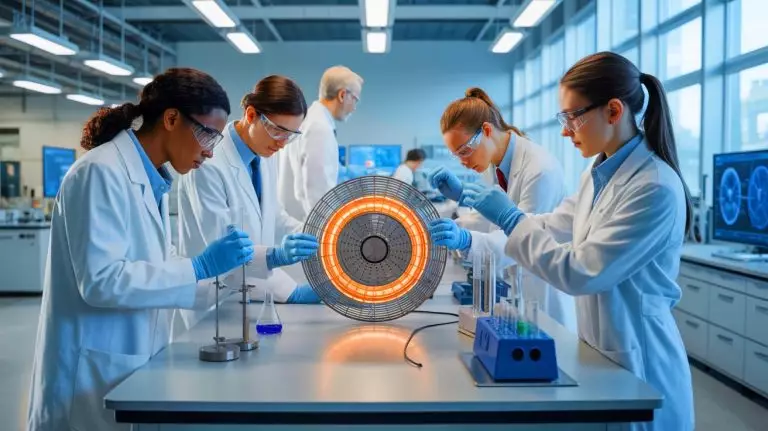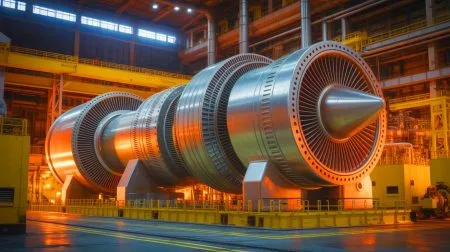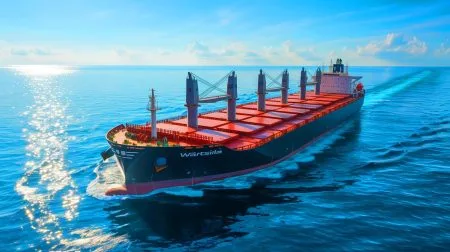| IN A NUTSHELL |
|
In an era where technological advancement is pivotal, the emergence of a groundbreaking innovation can shift the dynamics of global industries. A Chinese-born scientist, Jian-Ping Wang, currently based in the United States, has developed a novel magnet that could significantly disrupt China’s dominance in the magnet market. Utilizing iron and nitrogen, and notably devoid of rare earth elements, this super magnet promises to revolutionize sectors like electric vehicles, wind turbines, and medical devices, which have been traditionally reliant on China’s rare earth supply.
The Birth of a Game-Changing Innovation
Jian-Ping Wang’s revolutionary invention took root at the University of Minnesota, where he and his team pioneered the first iron-nitrogen-based magnet. Unlike conventional magnets that rely heavily on rare earth elements such as samarium or dysprosium, Wang’s creation boasts a magnetic field strength superior to any existing materials. This innovation could potentially replace the permanent magnets used in devices that convert electricity to motion, like those found in smartphones, electric vehicles, and MRI machines.
China has long held a stranglehold on the global rare earth market, controlling approximately 92% of the world’s refining capacity. This dominance has given China significant geopolitical leverage, especially as it curtails exports to the United States amid rising tensions. Wang’s magnet technology could thus serve as a strategic asset for the U.S., helping to mitigate dependency on Chinese-controlled resources and fostering a new era of technological independence.
Niron Magnetics: Pioneering a Sustainable Future
To bring this innovation to market, Jian-Ping Wang founded Niron Magnetics, a startup dedicated to producing high-performance, rare earth-free magnets. Targeting sectors like consumer electronics, the automotive industry, and industrial machinery, Niron Magnetics aims to deliver a more sustainable and cost-effective solution. The magnets are crafted using abundant and locally sourced materials, marking a significant step towards ecological responsibility.
Niron’s iron-nitrogen technology offers enhanced stability at high temperatures, a crucial feature for next-generation electric motors. This advancement not only promises improved performance but also aligns with global efforts to advance the transition to cleaner energy sources and reduce environmental impact.
Geopolitical Tensions Fueling Demand
The geopolitical landscape is increasingly influencing the demand for Niron Magnetics’ innovative solution. As China leverages its rare earth resources in response to U.S. restrictions on semiconductors, the pursuit of alternative technologies becomes more urgent. The global demand for permanent magnets is projected to triple by 2035, driven by the rapid growth of electric vehicles and renewable energy technologies.
This rising demand underscores the necessity for reliable, geopolitically stable supply chains. Niron Magnetics’ approach, rooted in local manufacturing and abundant materials, provides a strategic counterbalance to China’s market dominance, offering a pathway to greater technological sovereignty and economic resilience.
Local Manufacturing: A Strategy for Technological Independence
Niron Magnetics has embarked on the construction of its first manufacturing facility in Minnesota, setting the stage for large-scale production. The company’s industrial process is designed for rapid scalability, diverging from traditional technologies that rely on scarce and complex components.
This focus on local manufacturing represents a strategic move towards securing technological independence. By reducing reliance on imported materials and fostering domestic production, Niron Magnetics not only enhances the U.S.’s industrial capabilities but also aligns with broader national interests in securing critical supply chains.
The Global Market for Super Magnets
The global super magnet market, primarily dominated by neodymium-iron-boron (NdFeB) and samarium-cobalt (SmCo) magnets, was valued at approximately $45 billion in 2024. With a projected annual growth rate of 9.4%, this market is expected to reach $114 billion by 2034, fueled by the burgeoning demand for electric vehicles and renewable energy. Asia-Pacific, led by China, currently holds a significant market share, with key players also emerging in Japan, South Korea, and India.
Super magnets are integral to the functioning of electric motors, power steering systems, and wind turbines, all of which are experiencing rapid expansion. As governmental policies increasingly favor energy transition and technological innovation, the demand for high-performance magnets is set to soar.
| Year | Market Value (USD) | Growth Rate |
|---|---|---|
| 2024 | $45 billion | 9.4% |
| 2034 | $114 billion | – |
As Niron Magnetics continues to advance its groundbreaking technology, the potential for profound impacts on global industries is immense. The drive for innovation and sustainability is more critical than ever, and the question remains: How swiftly will these advancements reshape the landscape of global magnet production and consumption?
Did you like it? 4.5/5 (28)








Wow, if true, this could be a game-changer for the global magnet industry! 🎉
I’m skeptical. How can something so crucial be developed and China not replicate it?
Can these magnets be used in consumer electronics like smartphones and laptops?
Why hasn’t anyone thought of using iron and nitrogen before? Seems so simple!
Will this new magnet technology reduce the geopolitical tensions related to rare earth elements?
Great article, but I’m still confused about how this will impact the global economy. 🤔
Is there any potential for this technology to be used in renewable energy applications?
Are there any patents protecting this technology, or can other companies start producing similar magnets?
How soon can we expect these magnets to hit the market?
I’m all for innovation, but what about the jobs in the rare earth mining sector?
Can someone explain how these magnets work in layman’s terms? I’m lost! 😅
Is this article suggesting that China will lose its dominance in the magnet market?
I wonder if these magnets will be as strong as the rare earth magnets we use today.
Finally, a step towards reducing our dependency on China for rare earths! 🌍
Interesting read, but I’m not sure I buy it. What’s the catch?
How will this new magnet technology affect the environment compared to traditional rare earth magnets?
How will this innovation affect the price of electric vehicles?
Could this be a potential solution for the shortage of rare earth materials?
I’m curious if other countries will try to develop their own versions of this technology.
Thanks for sharing this! I look forward to seeing how this technology progresses. 👍
Does this mean the end for rare earth mining, or is that too optimistic?
I’m hopeful but cautious. Innovations like these often take a while to become mainstream.
China’s grip on the rare earth market has always been a concern. Is this finally a way to break free?
I’m curious about the cost of these new magnets. Are they cheaper to produce?
This sounds like a sci-fi movie plot. Magnets without rare earth? Amazing!
Thank you for the informative article! 🙏 It’s always exciting to read about innovations that could change the world.
Is there any information on how durable these magnets are compared to existing ones?